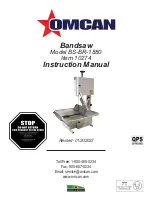
4
5
Symbology
Direct Current
No Load Revolutions per
Minute (RPM)
Underwriters Laboratories, Inc.
United States and Canada
c.
When restarting a saw in the workpiece, cen-
ter the saw blade in the kerf and check that
saw teeth are not engaged into the material.
If
saw blade is binding, it may walk up or kickback
from the workpiece as the saw is restarted.
d.
Support large panels to minimize the risk of
blade pinching and kickback.
Large panels
tend to sag under their own weight. Supports
must be placed under the panel on both sides,
near the line of cut and near the edge of the
panel.
e.
Do not use dull or damaged blade.
Unsharp-
ened or improperly set blades produce narrow
kerf causing excessive friction, blade binding and
kickback.
f.
Blade depth and bevel adjusting locking le-
vers must be tight and secure before making
cut.
If blade adjustment shifts while cutting, it may
cause binding and kickback.
g.
Use extra caution when making a "Plunge
Cut" into existing walls or other blind areas.
The protruding blade may cut objects that can
cause kickback.
10.
Check lower guard for proper closing before
each use. Do not operate the saw if lower
guard does not move freely and close in-
stantly.
Never clamp or tie the lower guard into
the open position. If saw is accidentally dropped,
lower guard may be bent. Raise the lower guard
with the retracting handle and make sure it moves
freely and does not touch the blade or any other
part, in all angles and depths of cut.
11.
Check the operation and condition of the
lower guard spring. If the guard and the
spring are not operating properly, they must
be serviced before use.
Lower guard may op-
erate sluggishly due to damaged parts, gummy
deposits, or a buildup of debris.
12.
Lower guard should be retracted manually
only for special cuts such as "Plunge Cuts"
and "Compound Cuts". Raise lower guard
by retracting handle and as soon as blade
enters the material, the lower guard must be
released.
For all other sawing, the lower guard
should operate automatically.
13.
Always observe that the lower guard is
overing the blade before placing saw down
on bench or fl oor.
An unprotected, coasting
blade will cause the saw to walk backwards,
cutting whatever is in its path. Be aware of the
time it takes for the blade to stop after switch is
released.
14.
Maintain labels and nameplates.
These carry
important information. If unreadable or missing,
contact a
MILWAUKEE
service facility for a free
replacement.
15.
WARNING:
Some dust created by power sand-
ing, sawing, grinding, drilling, and other construc-
tion activities contains chemicals known to cause
cancer, birth defects or other reproductive harm.
Some examples of these chemicals are:
• lead from lead-based paint
• crystalline silica from bricks and cement and other
masonry products, and
• arsenic and chromium from chemically-treated
lumber.
Your risk from these exposures varies, depending
on how often you do this type of work. To reduce
your exposure to these chemicals: work in a well
ventilated area, and work with approved safety
equipment, such as those dust masks that are
specifi cally designed to fi lter out microscopic
particles.
Depth of Cut
at 45°
0 to 1-9/16"
Blade
Size
6-1/2"
Cat.
No.
6310-20
Depth of Cut
At 90°
0 to 2-1/8"
Arbor
5/8"
No Load
RPM
3200
Volts
DC
18
Specifi cations
FUNCTIONAL DESCRIPTION
1. Lock-off
button
2. Trigger
3. Handle
4. Shoe
5. Lower guard lever
6. Lower
guard
7. Blade
bolt
19
21
20
8. Blade
fl ange
9. Blade
10. Sight line
11. Rip fence slot
12. Rip fence adjusting knob
13. Upper guard
14. Front handle
15
16
17
18
2
3
4
5
6
7
8
9
10
11
12
13
14
1
15. Depth setting gauge
16. Wrench
17. Spindle lock button
18. Depth adjusting lever
19. Bevel adjusting knob
20. Bevel pointer
21. Bevel scale




































